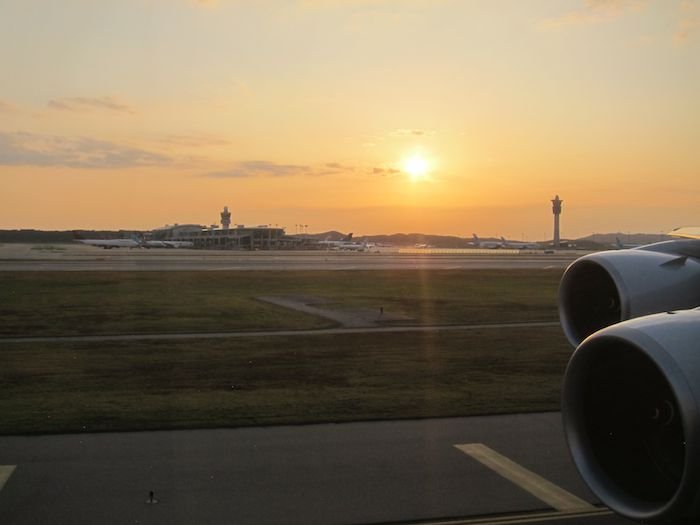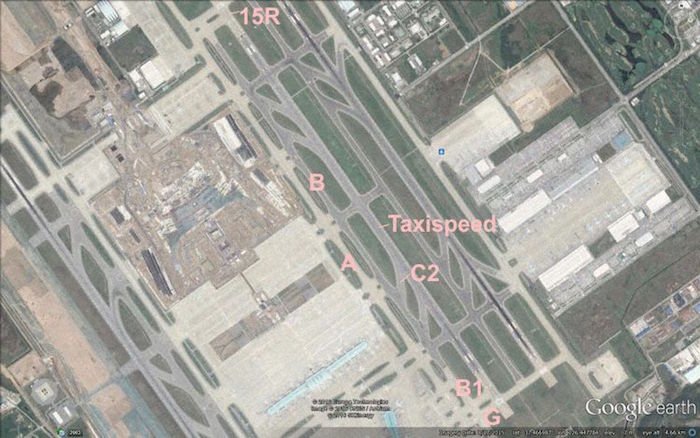I read avherald.com on a daily basis, which covers airline incidents and news. I noticed they covered a case at Seoul Incheon Airport on May 5, where a Singapore Airlines 777 had to abort its takeoff due to a Korean Air A330 crossing the runway without permission.

Seoul Incheon Airport
Incidents involving planes crossing runways without permission always immediately remind me of the Tenerife Disaster, which is the single worst aircraft accident in history. During this incident two 747s collided on a runway, killing 583 people.
Several media outlets have picked up on the Singapore Airlines & Korean Air situation at Incheon Airport, labelling it a near miss. First of all, I don’t actually understand the term “near miss.” Shouldn’t it be “near hit?” Comedian George Carlin (RIP) had a great joke about this back in the day:
Anyway, The Aviation Herald has a good explanation of what happened. To summarize:
- A Singapore Airlines 777-300ER bound for San Francisco began its takeoff roll on runway 15R
- Moments later a Korean Air A330-200 (incorrectly) joined a taxiway which crosses runway 15R
- The Singapore Airlines 777-300ER had their takeoff clearance canceled; at this point they were going 105 knots, and they managed to slow down 5,100 feet away from the Korean Air A330-200
- Due to overheating, the tires on the Singapore Airlines 777-300ER deflated, causing the flight to be delayed by about 19 hours
- The Korean Air A330-200 returned to the gate, incurring about a 100 minute delay
It’s obvious that the Korean Air plane was in the wrong. I’m also curious why the Korean Air plane returned to the gate. Did they want to start an investigation of the pilots right away? If so, was Korean Air able to find a replacement cockpit crew that quickly?
More importantly, was this actually a narrowly avoided catastrophe? While any situation where a plane enters an active runway without permission is inexcusable and worthy of an investigation, this situation was unlikely to end in catastrophe, even without intervention:
- The taxiway on which the Korean Air plane crossed the runway (marked “G” in the below diagram) was at the very end of the ~12,300 foot runway, so the Korean Air plane was crossing at the furthest possible point of the runway
- Without intervention, the Singapore Airlines plane would have taken off well ahead of where the Korean Air plane was crossing
- Even with the high speed aborted takeoff, the Singapore Airlines plane stopped with roughly a mile of runway left

Map via The Aviation Herald
None of this is to downplay the ridiculousness of crossing an active runway without permission, but it is to say that I don’t think this was quite a near-repeat of the Tenerife Disaster.





The KAL aircraft took a wrong turn into G (it's start position was unusually close to the main taxiway which may have contributed to the pilots mis-identifying their position). I believe they stopped before entering the runway but, I was told, still triggered a sensor alerting the tower to an impending runway incursion.
I don't really get this. If the A330 was crossing the take-off runway at the far side of that runway, then the 777 would have been airborne well before then.
So aborting the 777 actually makes it more dangerous to my mind, because it then has to stay on the runway and hope it stops before hitting the A330 (which it presumably would avoid anyway under V1.) The danger is not if the 777 takes...
I don't really get this. If the A330 was crossing the take-off runway at the far side of that runway, then the 777 would have been airborne well before then.
So aborting the 777 actually makes it more dangerous to my mind, because it then has to stay on the runway and hope it stops before hitting the A330 (which it presumably would avoid anyway under V1.) The danger is not if the 777 takes off but if it doesn't.
I get that procedures demand that the take-off be aborted but wouldn't it be safer to not abort in this case?
Why do you say that the KE flight was at fault? Isn't it equally likely that ATC was at fault?
You question why the Korean Air A332 returned to gate. That is standard operating procedure for all airlines all over the world in cases like this. Would you feel safe in an airplane with pilots thinking about what just happened, which in worst case could have ended in a collision? Runway incursions on active - and especially occupied - runways are an extremely serious matter.
And why compare it to the Tenerife disaster? The situations...
You question why the Korean Air A332 returned to gate. That is standard operating procedure for all airlines all over the world in cases like this. Would you feel safe in an airplane with pilots thinking about what just happened, which in worst case could have ended in a collision? Runway incursions on active - and especially occupied - runways are an extremely serious matter.
And why compare it to the Tenerife disaster? The situations are so different, especially when it comes to the reasons why what happened happened.
Here's a discussion on the origin of the term "near miss"
http://www.worldwidewords.org/qa/qa-nea1.htm
As a Boeing pilot, I'd say you got it right Ben. Korean seems to have gone past the hold short line. That is crossing the boundary of the runway, not actually on to the runway. And it is the far end of the runway, a portion not to be used for take off roll, but in case of a rejected takeoff.
However, in most cases the Singapore plane would have selected a reduced thrust...
As a Boeing pilot, I'd say you got it right Ben. Korean seems to have gone past the hold short line. That is crossing the boundary of the runway, not actually on to the runway. And it is the far end of the runway, a portion not to be used for take off roll, but in case of a rejected takeoff.
However, in most cases the Singapore plane would have selected a reduced thrust to save engine life, so a reject would come much closer than that mile you are talking about, if it happened at the worst case scenario. Very roughly, a light plane uses the same amount of runway as a heavy plane, cause we adjust the power to not sue more than needed for the configuration, runway length, obstacles and initial climb etc, calculated before every take off. (there are many reason for not using reduced thrust, such as weather, malfunctions of some equipment, etc, but mostly it is used).
For safety, takeoff clearances are cancelled if someone gets past the "hold short lines". So are landing clearances. Runway incursions are considered serious incidents. Even if you can argue that it wasnt really close to an accident. History has shown that it is very dangerous, with thousands of casualties, so that is why the industry and pilots takes incidents like this so seriously.
@Dean prob Korean Air's insurance company since they were at fault unless they find that ATC was at fault.
Good god. It is irrelevant that the SQ aircraft stopped with runway to spare, or that the KE aircraft crossed the runway at the furthest point. This was a runway infraction, plain and simple, and it is a serious incident whatever the likelihood of catastrophe.
This was enough below V1 to be comfortable, but approaching 150 knots or so it would've been scarier. A lot more heated brakes if aborting (potential for fire), and if past V1 gotta fly over the other plane.
Assuming the pilots followed their training, there shouldn't have been a collision but it would be gut wrenching.
IIRC, the FAA refers to two different types of ground based incidences involving runways. A runway incursion occurs when an aircraft crosses the hold short line onto an active runway prior to ATC clearance. If there is another aircraft departing or landing on that runway, it's a "near miss."
Near miss isn't the only paradoxical term in the aviation industry. "Vacuum Pressure" is the one that really drives me nuts.
I can see...
IIRC, the FAA refers to two different types of ground based incidences involving runways. A runway incursion occurs when an aircraft crosses the hold short line onto an active runway prior to ATC clearance. If there is another aircraft departing or landing on that runway, it's a "near miss."
Near miss isn't the only paradoxical term in the aviation industry. "Vacuum Pressure" is the one that really drives me nuts.
I can see how a runway near miss could remind you of the Tenerife tragedy, but it should be noted that the circumstances leading to the crash were quite the opposite of this incident.
- Both 747s were cleared to be on the runway simultaneously.
- The lead 747 began its takeoff roll prior to receiving ATC clearance.
- The visibility was impossibly low.
- A series of communications breakdowns, both between the tower and the flight crews, and on the flight
decks, were a major catalyst for the crash.
It appears that a major catastrophe was avoided in Singapore because everyone, except the Korean flight crew, performed exactly as they were trained.
So, in this case, who foots the bill for the 19hr delay? KE's insurance? Surely, SQ is not going to be the one who will want to pay for all the costs incurred by this incident?
I'm a bad pilot and suck. But Korean pilots really stink. CRM, have not clue? Culture blah blah, but what a pain in the butt. Just follow commands and pay attention to the airspeed when its severe clear on approach to SFO. Or have a clue on the ILS in Guam. JC.
Regarding "None of this is to downplay the ridiculousness of crossing an active runway without permission, but it is to say that I don’t think this was quite a near-repeat of the Tenerife Disaster."
Ben, I'm not sure where I see anyone comparing it to Tenerife at all. Also, for those who click on the link to the article, avoid the comments unless you want YouTube level discussion.
What I don't understand is why the...
Regarding "None of this is to downplay the ridiculousness of crossing an active runway without permission, but it is to say that I don’t think this was quite a near-repeat of the Tenerife Disaster."
Ben, I'm not sure where I see anyone comparing it to Tenerife at all. Also, for those who click on the link to the article, avoid the comments unless you want YouTube level discussion.
What I don't understand is why the KE 330 was crossing the active runway at all, unless ATC was changing the takeoff direction at that very time.
Also, FYI not sure you got to it yet I sent you an email re: S. Africa a couple of days ago.
Disagree, this had the potential to be disastrous... Hence the hype.